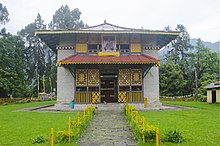| Dubdi Monastery. | |
|---|---|
 Dubdi Monastery | |
| Religion | |
| Affiliation | Tibetan Buddhism |
| Sect | Nyingma |
| Location | |
| Location | Yuksom, Sikkim, India |
| Country | India |
| Geographic coordinates | 27°04′N 88°28′E / 27.067°N 88.467°E |
| Architecture | |
| Style | Tibetan |
| Founder | Lhatsun Namkha Jigme |
| Yuksom, Norbugang Chorten, Norbugang Coronation Throne and the Kathok Lake are within its precincts | |
Dubdi Monastery, occasionally called Yuksom Monastery, is a Buddhist monastery of the Nyingma sect of Tibetan Buddhism near Yuksom, in the Geyzing subdivision of West Sikkim district, in eastern India.[1][2]
The Chogyar Namgyal established the first monastery known as the Dubdi Monastery in 1701, at Yuksom in Sikkim, which is part of Buddhist religious pilgrimage circuit involving the Norbugang Chorten, Pemayangtse Monastery, the Rabdentse ruins, the Sanga Choeling Monastery, the Khecheopalri Lake and the Tashiding Monastery.[3][4]
Established in 1701, it is professed to be the oldest monastery in Sikkim and is located on the top of a hill which is about an hour's walk (3 kilometres (1.9 mi)) from Yuksom.[5] It was also known as the Hermit's Cell after its ascetic founder Lhatsun Namkha Jigme, who along with two other lamas from Tibet met at Norbugang near Yuksom and crowned Phuntsog Namgyal as the first King or Chogyal of Sikkim at Norbugang Yuksom in 1642. The literal meaning of 'Dubdi' in local language is "the retreat".[1][6][7]
- ^ a b "Monasteries". sikkiminfo.in. Archived from the original on 13 February 2010. Retrieved 21 November 2009.
- ^ "Monasteries in Sikkim are of three types". Dubdi Monastery. Sikkim Info. Archived from the original on 27 May 2010. Retrieved 5 May 2010.
- ^ Choudhury, Maitreyee (2006). Sikkim: Geographical Perspects. Mittal Publications. pp. 80–81. ISBN 81-8324-158-1. Retrieved 5 May 2010.
- ^ Singh, Sarina (2005). India. Lonely Planet. p. 529. ISBN 1-74059-694-3.
trail leads to Sikkim's oldest gompa, Dhubdi Monastery. The monastery was established in 1701 and enshrined within it are the statues of the three famous lamas
- ^ Datta, Rangan (10 December 2021). "A sojourn to the first capital of Sikkim". No. My Kolkata. The Telegraph. Retrieved 9 August 2023.
- ^ "Yuksom in Sikkim". India Study Channel. Retrieved 7 May 2010.
- ^ "Monasteries". Dubdi Monastery. National Informatics Centre. Archived from the original on 28 August 2010. Retrieved 5 May 2010.
